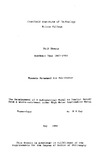JavaScript is disabled for your browser. Some features of this site may not work without it.
| dc.contributor.advisor | Kay, M. G. | |
| dc.contributor.author | Abo-Ghobar, Hussein Mohammed Ali | |
| dc.date.accessioned | 2013-03-07T15:19:46Z | |
| dc.date.available | 2013-03-07T15:19:46Z | |
| dc.date.issued | 1988-05 | |
| dc.identifier.uri | http://dspace.lib.cranfield.ac.uk/handle/1826/7840 | |
| dc.description.abstract | Current trends in sprinkler irrigation to improve application uniformity and reduce energy requirements haste led to problems of water application and potential surface runoff, which in turn have highlighted the importance of the soil and cultivation practice in making best use of irrigation water. The objective of this study was to begin the development of a mathematical model, which will simulate the operation of current sprinkler-soil-crop system, in order to provide a means of predicting surface runoff and so provide a more effective approach to system design. A model has now been developed which will predict runoff from a small simple agricultural catchment in the form of a ridge and furrow ciltivation system. The model is based on the kinematic wave theory involving the continuity equation and the simplified momentum equation. A four-point implicit finite difference scheme is used to solve numerically the kinematic wave equations. The model (SROFF) may be used to predict the runoff at various times from a simple catchment with different slopes, water application rates and soil infiltration rate. A further development of the model was made by the introduction of the interception loss model (INCEPT) to predict the amount of water intercepted by the crop canopy during irrigation. The validity of the model was tested and supported by the results of laboratory experiments conducted on two soil samples with different infiltration rates, using three different application rates. The performance of the model was also evaluated by statistical test. There was good agreement between experiment and model results. The results indicated that this model can provide valuable information for the effective design of sprinkler systems, particularly where runoff may be a potential problem. This is particularly the case with current low pressure irrigation systems but equally the problem is common with high pressure systems when applied to soils with low infiltration rates. | en_UK |
| dc.language.iso | en | en_UK |
| dc.publisher | Cranfield University | en_UK |
| dc.title | The Development of A mathematical Model to Predict Runoff From A micro-catchment under High Water Application Rates | en_UK |
| dc.type | Thesis or dissertation | en_UK |
| dc.type.qualificationlevel | Doctoral | en_UK |
| dc.type.qualificationname | PhD | en_UK |
